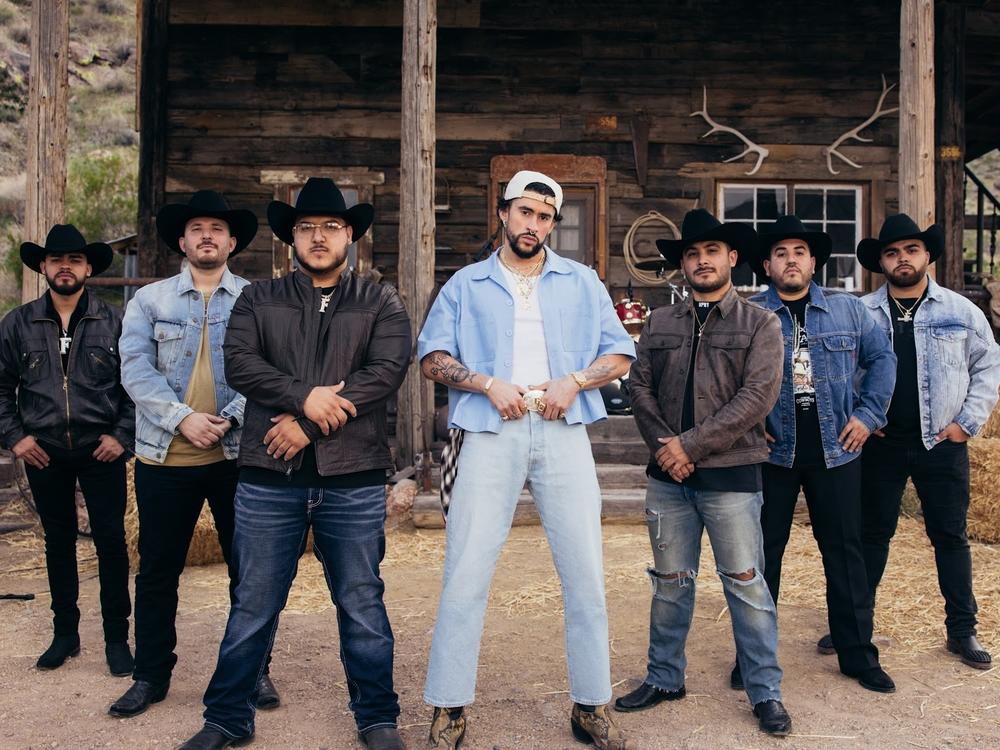Section Branding
Header Content
Why regional Mexican's current explosion catapults the genre to new heights
Primary Content
This past weekend at Coachella, Bad Bunny made history by becoming the first Spanish-language artist to headline the festival. But on Monday, the Puerto Rican rapper made waves beyond the festival grounds with a surprising new song that doesn't sound anything like the reggaeton that's shot him to global pop stardom.
Instead, Bad Bunny released "un x100to," a collaboration with the band Grupo Frontera, a regional Mexican group. From one of the biggest pop stars on the planet, it's a song that represents a much larger trend. Regional Mexican music, often a sentimental, traditional genre encompassing cumbia and acoustic guitar-driven music, is only growing in popularity. This week, a regional Mexican song entered the top 10 of the Billboard Hot 100 chart for the first time in the chart's history: "Ella Baila Sola," by the rapidly rising star Peso Pluma and Eslabon Armado. In the past few years, the once regional genre has exploded on an international stage, as global pop artists begin to take cues from its sound.
But regional Mexican's steady resurgence and reinvention is more than just a fad, fueled by changing social media platforms that connect a Spanish-speaking diaspora and themes that speak to a generation in crisis. All Things Considered's Juana Summers spoke with Alt.Latino's Anamaria Sayre and NPR's Mexico City correspondent Eyder Peralta to explain why this explosion is a watershed moment for the genre.
This conversation has been edited for length and clarity. To listen to the audio version of this story, please click the player above.
Why is Bad Bunny's regional Mexican turn surprising?
Eyder Peralta: I was surprised because leading up to this moment urban and pop music had been kind of sneaking its way into these regional Mexican songs. But when the biggest pop star in the world decides to dip in, he does it with a straight up, uncomplicated, traditional Texas cumbia.
Anamaria Sayre: I must admit, when I heard that Bad Bunny was going to be doing some regional, this is not what I expected. The only real reggaeton connection here are Bad Bunny's vocals — we all know them, and hearing them over this instrumental is really striking. But that and this super modern story. I mean, stalking an ex on Instagram? His phone's on one percent? That feels pretty Bad Bunny to me.
"Ella Baila Sola" by Peso Pluma marks a watershed moment for regional Mexican music
Peralta: ["Ella Baila Sola"] by Peso Pluma ... is the perfect example of what's known as a corrido tumbado. They're these stripped down songs of heartbreak or, in this case, it's about a guy who is trying to woo a girl who's dancing alone at a party. They're throwbacks to Mexican country music, but they have a hip-hop swagger. And this song is already a massive hit.
Sayre: It's really struck a nerve. We all know Selena and we thought that she was the person that was taking regional beyond the region, but this song just cracked the top ten of Billboard's Hot 100 chart. This is really a watershed moment for the genre, but for those of us who've been tracking it, it's not coming out of nowhere. We've been watching this build for years from something that was just in the northern region of Mexico to something listened to in the country at large, and now we're seeing it hit the international stage.
We saw a number of regional artists perform at Coachella this past week, like the soft rock, corrido fusion [artist] Danny Lux, poppy heartthrob Becky G who brought out record-breaking Peso Pluma, and we're watching this happen at the same time as international artists like Bad Bunny and Karol G are adopting the genre.
How regional Mexican has changed over time
Peralta: It has deep roots. It really reaches back more than 150 years when Mexicans would write songs about wars and revolutionary heroes. But more recently, that changed and became about the life of drug runners or, in the case of Los Tigres del Norte, about life as an immigrant in the U.S.
Sayre: It's always been something that Mexicanos have leaned on as something that speaks to their experience. But it was very much known and seen as not only something distinctly Mexican, but specifically a genre that was confined to the northern part of the country — something that had a bit of a stigma around it as being rancho music, [which] wasn't well respected in the country. But everything is changing right now.
Why this explosion is happening now
Sayre: Eyder and I definitely have our theories. One is that I think the Latin American diaspora, the Spanish speaking diaspora, has never been more united than it is in this moment. I think [with] platforms like TikTok, Spotify, we can really attribute some of that unification to the way that people are able to connect and find something of each other's histories and sonic legacies within each other's music.
Peralta: I think we have to remember that for a long time Mexico was the center of the Latin Latin cultural universe. As reggaeton took over the world, that center drifted toward the Caribbean and now it's just drifting back to Mexico. And Mexican music has historically been amazing at helping us process sadness — no one else on the continent does it better, I don't think anybody will fight me on that. A lot of these songs are about loss and pain and yearning, and they're coming at a particularly precarious time for our planet. These songs are just finding their moment.
Sayre: I don't think it's a coincidence that the young generation of today is really into their sensitive boys. Peso Pluma does that better than anyone.
Copyright 2023 NPR. To see more, visit https://www.npr.org.

